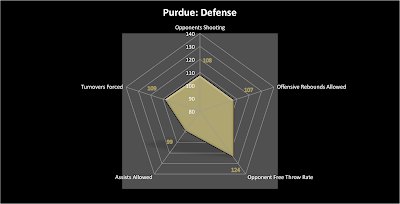On a young Iowa Hawkeye team, Jarryd Cole was the lone Senior in the starting lineup. Considering Cole's story is probably fresh in your mind from the lead up to the Senior Day game against Purdue, I won't repeat it. That isn't what this post is about anyways. This post is to review his Senior year, which turned out to be a pretty good one.
It began a little shaky in November, as he started the season with an injury (foot?), which led to him playing only 18.86 minutes per game. However, even with limited playing time, he still averaged 0.32 points per minute in November, while grabbing a 5.71% offensive rebounding rate and a 18.23% defensive rebounding rate. In December, Cole's playing time increased, his points per minute stayed steady, and his rebounding exploded. His offensive rebounding rate for the month was an insane 22.92% (small sample sizes, but wow!), and his defensive rebounding rate was 23.89%. He was at the top of his game.
Then January came, and Cole went silent. His offensive rebounding rate fell back down to around 5%, and his defensive rebounding rate came down to an okay, but not great 14.66%. Not to mention, his points per minute fell to 0.24 (yikes!). I was a little worried, thinking that the tougher competition was getting the best of Cole. No worries, though, as he just needed the Calendar to turn. In February/March, his points per minute shot up to his best of the year, topping out at 0.36. It was partially due to a little good luck, as he shot an unsustainable 64.18% eFG% in those ten games (small sample sizes!), but he was still good. His offensive rebounding rate in February/March, was a more realistic 9.39%, as was his 20.09% defensive rebounding rate (both very close to his season averages). Even though Cole had some rough spots this season, he was still one of the most dependable players on the team. Especially, down the stretch.
Strengths:
- Rebounding- With a 10.63% offensive rebounding rate, that was good enough for ninth best in the Big 10. Not to mention, a 19.25% defensive rebounding rate, that finished eighth in the conference. It's pretty safe to say that rebounding was a strength for Cole. Basabe and Archie were the two best rebounders on the team, but Cole wasn't too far behind. He actually outperformed Basabe on the defensive boards in December and February/March. So, he definitely deserves some credit.
- Getting to the Free Throw Line- Not including Devon Archie, who only attempted 32 field goals this year, Cole led the team in free throw rate (free throws attempted per field goals attempted). On the year, he took 93 free throws compared to 162 field goal attempts, good for a 0.57 free throw rate. Never once, did he drop below 0.42 for any month (team average = 0.34). In fact, in December he had a ridiculous 0.86 free throw rate. He attempted 25 free throws compared to 29 field goals. Just to see crazy his December was, here's a graph:

- Shooting- Even though Cole isn't known for his scoring ability, he was actually a very efficient scorer. He finished his career with 59.60% eFG% (never dipping below 56.7% in his four years at Iowa), and he averaged 1.20 points per scoring attempt this year (second best on the team). I should also mention, that his 78.41% FG% on shots in the paint was the best on the team, and his 31.51% FG% on two point shots outside the paint was second on the team, behind only Gatens. Just for reference, the team average FG% on shots in the paint was 68.86% and 28.17% for two point shots outside the paint. Have I made Jarryd's case yet? He was a pretty damn good shooter.
Weaknesses:
- Blocks- This is probably nitpicking, and I'm not saying he wasn't good on defense. I don't recall yelling at my TV because Cole had some mental lapse on defense. He actually looked good on defense, mostly because he had a big physical body, that could bang with the bigger post players. However, he was an undersized center. So, it probably isn't that surprising that he was not that great at rejecting opponents shots. But, considering he never topped a 2% block rate his entire career at Iowa, is kind of surprising to me. Blocks aren't a huge deal, but Cole's game was pretty well-rounded during his Senior year. He wasn't a huge scoring threat, but he was never seen as the top scoring option on the team. He also cut his turnovers this year, by a lot. And so he didn't really leave much for me to complain about. Feel free to let me know if I'm missing anything, but I think Cole had a very nice Senior season.











